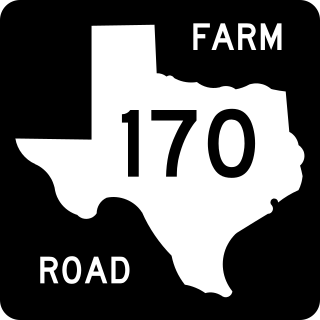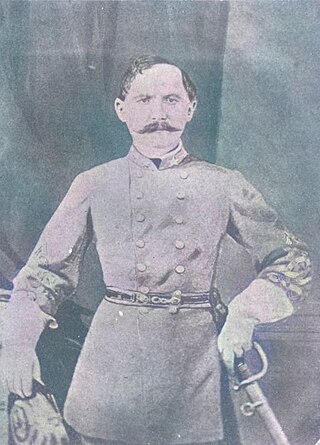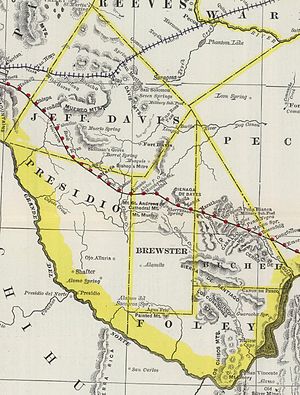
The Arctic Archipelago, also known as the Canadian Arctic Archipelago, is an archipelago lying to the north of the Canadian continental mainland, excluding Greenland and Iceland.

San Augustine County is a county located in the U.S. state of Texas. As of the 2020 census, its population was 7,918. Its county seat is San Augustine.

Presidio County is a county located in the U.S. state of Texas. As of the 2020 census, its population was 6,131. Its county seat is Marfa. The county was created in 1850 and later organized in 1875. Presidio County is in the Trans-Pecos region of West Texas and is named for the border settlement of Presidio del Norte. It is on the Rio Grande, which forms the Mexican border.

Jeff Davis County is a county in the U.S. state of Texas. As of the 2020 census, its population was 1,996. Its county seat is Fort Davis. The county is named for Jefferson Davis, who served as the 23rd United States Secretary of War in the 1850s, and as Confederate president.

Brewster County is a county located in the U.S. state of Texas. It is in West Texas and its county seat is Alpine. It is one of the nine counties that comprise the Trans-Pecos region, and borders Mexico. Brewster County is the largest county by area in the state - at 6,192 square miles (16,040 km2) it is over three times the size of the state of Delaware, and more than 500 square miles (1,300 km2) bigger than Connecticut.

Alpine is a city in and the county seat of Brewster County, Texas, United States. The population was 6,035 at the 2020 census. The town has an elevation of 4,462 feet (1,360 m), and the surrounding mountain peaks are over 1 mile (1.6 km) above sea level. A university, hospital, library, and retail make Alpine the center of the sprawling 12,000 square miles (3,108,000 ha) but wide open Big Bend area including Brewster, Presidio, and Jeff Davis counties.

Goliad is a city and the county seat of Goliad County, Texas, United States. It is known for the 1836 Goliad massacre during the Texas Revolution. It had a population of 1,620 at the 2020 census. It is part of the Victoria, Texas, Metropolitan Statistical Area.

Presidio is a city in Presidio County, Texas, United States. It is situated on the Rio Grande River, on the opposite side of the U.S.–Mexico border from Ojinaga, Chihuahua. The name originates from Spanish and means "fortress". The population was 4,169 at the 2000 census, and had increased to 4,426 as of the 2010 US census.

The Big Bend is part of the Trans-Pecos region in southwestern Texas, United States along the border with Mexico, north of the prominent bend in the Rio Grande for which the region is named. Here the Rio Grande passes between the Chisos Mountains in Texas and the Sierra Madre Oriental in Mexico as it changes from running east-southeast to north-northeast. The region covers three counties: Presidio County to the west, Brewster County to the east, and Jeff Davis County to the north.
Jiménez is a town and seat of the municipality of Jiménez in the Mexican state of Coahuila, at an altitude of 250 meters above sea level. It is located on the confluence of the Río San Diego and the Rio Grande bordering with the U.S. state of Texas. It had a population of 1,160 inhabitants in the 2010 census, and is, unusually for a Mexican municipal seat, the second-largest locality in the municipality, after the town of San Carlos.

The Trans-Pecos, as originally defined in 1887 by the Texas geologist Robert T. Hill, is the distinct portion of Texas that lies west of the Pecos River. The term is considered synonymous with Far West Texas, a subdivision of West Texas. The Trans-Pecos is part of the Chihuahuan Desert, the largest desert in North America. It is the most mountainous and arid portion of the state, and most of its vast area is sparsely populated. Among the nine counties in the region are the five largest counties by area in Texas and eight of the eleven largest in the state. The area is known for the natural environment of the Big Bend and the gorge of the Rio Grande, part of which has been designated a National Wild and Scenic Rivers System. With the notable exceptions of Big Bend Ranch State Park, Big Bend National Park and the Guadalupe Mountains National Park, the vast majority of the Trans-Pecos region consists of privately owned ranchland. However, most of the region's population reside in the El Paso metropolitan area. Besides El Paso and its metropolitan area, the major cities are Pecos (12,916), Fort Stockton (8,466), and Alpine (6,035). All other settlements have under 5,000 people.

Chihuahuan Desert Nature Center and Botanical Gardens is a nonprofit nature center with botanical gardens on the grounds of the Chihuahuan Desert Research Institute, the parent organization. It is located off Texas State Highway 118 about 4 miles (6.4 km) south of Fort Davis, Texas, United States. The Center is open Monday through Saturday, except major holidays. An admission fee is charged.

Farm to Market Road 170 is a 114.6-mile (184.4 km) highway maintained by the Texas Department of Transportation (TxDOT) in Presidio and Brewster counties in Texas. The route, known locally as the River Road, runs along the United States side of the Rio Grande which in Texas forms the international boundary between the U.S. and Mexico. The road runs from Candelaria through the city of Presidio as well as several smaller communities and former settlements to State Highway 118 in Study Butte near Big Bend National Park. The road also passes through the southern portion of Big Bend Ranch State Park.
The A. S. Gage Ranch is a 190,000-acre (770 km2) cattle ranch located in Brewster and Presidio Counties in west Texas. Today's ranch is only a part of what was a once much larger operation founded in 1883 by Alfred S. Gage. It is still in the family, being owned and operated by Alfred's great grandchildren who are children of Alfred Negley, Joan Kelleher and Roxana Hayne. The operations consist of cattle raising and hunting.

Buchel County was a former Texas county. Its area is now completely contained in the present Brewster County.
Post Park is a small county park in Brewster County, Texas, United States. The park is the site of Peña Colorado Springs. This year-round spring long-provided fresh water to the Comanche and other nomadic native peoples, serving as a stop on the Comanche Trail. Beginning in 1879, the springs were the site of the United States Army's Camp Peña Colorado. In 1884, the 10th Cavalry, also known as the buffalo soldiers were stationed at the Camp. The Army abandoned the Camp in 1893. The land around the springs was donated to Brewster County in 1935.
Needle Peak is the local nickname for the Sierra Aguja in Brewster County, Texas, a small range near the Mexican border and just west of Big Bend National Park. Not to be confused with Needle Peak in Presidio County, Texas, about 17 miles away.
The Trans-Pecos Volcanic Field is a volcanic field located in western Texas in the counties of Brewster, Jeff Davis, Presidio, and extends into northern Mexican states of Chihuahua and Coahuila. It is the southernmost volcanic field to be documented and recorded in the continental United States. The field started volcanic activity around 48 million years ago in the middle Eocene epoch, and ended around 17 million years later in the Miocene epoch.

Augustus Carl Buchel was a German-born military officer who served in several national armies during the 1800s. During the American Civil War, he served as a colonel in the Confederate States Army.

















